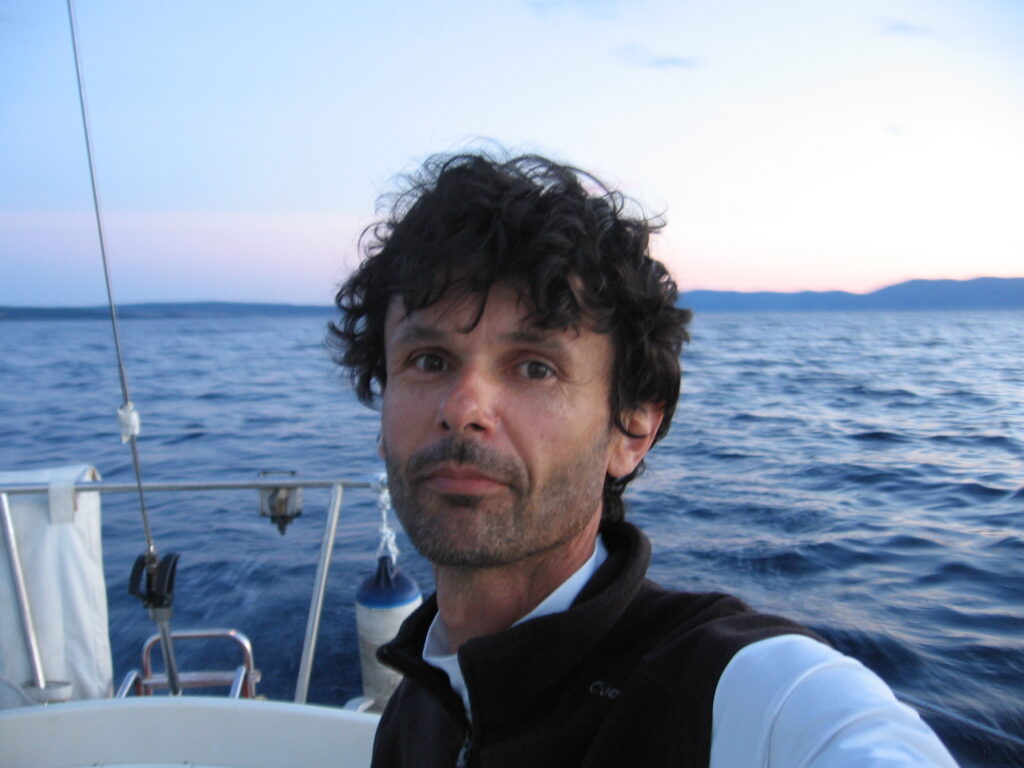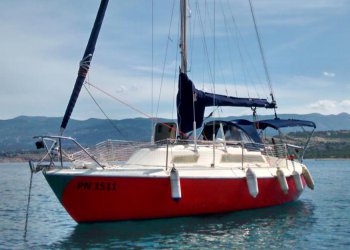Wandering Tomahawk in the North Adriatic
As far as I know, Bora II is one of two Tomahawks in Croatia. Both have their home port in Rijeka bay on the east coast of the Northern Adriatic. Mine is located in the small town of Omišalj on the island of Krk (you will soon find out that the names of Croatian towns and islands are notoriously difficult to pronounce for non-Slavic speakers).
I did not change the name when I bought Bora II in 2013; earlier, she sailed under German flag, while the first owner was from Austria, so she also sailed under Austrian flag. Her original name was Gerlinde (which seems to be a female name), while the Bora is an Italian name for the NE wind, known in Croatian as Bura. This brings us to the weather conditions on the east coast of Northern Adriatic.

Fig 1: Omišalj
Weather
In maritime affairs, east coast of Northern Adriatic is almost a synonym for Bura. Bura is a cold, strong, gusty NE wind that often reaches hurricane force in winter, especially in some places. The main cause of such nature of Bura are the high mountains along the coast all the way to the central part of the Adriatic Sea. Trieste, an Italian city 40 miles north of me, famous for the sailing regatta Barcolana, is also known for Bura. Only a few places in the south have problems with the Bura; they have problems with the jugo, a SE wind. Since the jugo is associated with low pressure, it is not so problematic in summer. But the Bura can also blow strongly in summer, although much less intense and lasting shorter than in winter. Few facts: the strongest registered Bura gust was 134 knots; a mile away from my home port there is a bridge with strongest gust recorded 114 knots. The average hourly speed of the Bura can reach 57 knots; the typical duration is three days, although in winter it can last 10 days in some places.
In 1962 the Bura deposited 440 pounds of sea salt per hectare for three days on the island of Rab (the area of the island of Rab is 9600 hectares, which is equivalent to 37 square miles). Such large quantities of salt are the reason why there is almost no vegetation on the northern sides of the islands, a moon-like landscape. On the other hand, the sparse grass that grows there is an excellent pasture for sheep, so lamb is a special delicacy here. A quick look at the map shows many islands, so one might think that there are also many places to hide from the Bura. This is not the case, these islands are quite high with steep sides, so the Bura simply rushes down, causing the gusts to increase and create bigger waves.
So, what happens on other days when the Bura does not blow? I am reading a nautical guide that says: “The frequency of thunderstorms in Northern Adriatic is the highest in Europe”. In the summer months there are usually nine days with thunderstorms in Northern Adriatic, four in the Southern Adriatic. Thunderstorms occur in the afternoon and are usually short-lived. Only when a low is approaching they can last longer.
The problem in summer is that there are many inexperienced sailors around, so anything can happen at the anchorage in case of a sudden thunderstorm; the best strategy is to leave the anchorage and weather the storm far from the coast. This bring us to waterspouts; again, these are most often found on parts of Northern Adriatic. But I do not want to scare you, you just have to follow the weather forecast and be careful. Although the Rijeka Bay is not a sailing area, because either there is no wind or a strong Bura is blowing, when you leave the bay, in the afternoon you can find great mistral winds (NW) for sailing or nocturnal winds blowing from land or islands. To find the latter, you have to get up very early, because the fun stops when the sun appears on the horizon.
August 2020 trip
Now that you are familiar with the weather in the region, I can start to describe the wanderings of Bora II in August this year. I am not an experienced sailor, Bora II is my first boat, but I usually sail single-handed, so this was the case on this occasion. We started the trip at 5 o’clock in the morning from Omišalj. Omišalj is a beautiful old town, which was built next to the ancient Roman settlement Fulfinum. Unfortunately, there are many industrial plants in the region, which ruin the landscape. You should also know that near the bridge I mentioned earlier, in 49 B.C. a naval battle took place between Julius Caesar’s and Pompey’s fleets. The fleet of Caesar lost and the surviving soldiers built a raft of barrels and managed to escape. It is said that this is the first written mention of a barrel in history.
So, Bora II sailed to Vela Vrata (literally: Big Door), a passage between the Istrian peninsula and the island of Cres, one of the largest islands in the Adriatic. We caught a fine nocturnal wind – Tramontana, which blows from a small bay at the northernmost point of the Rijeka bay. We managed to sail out of the Rijeka bay with 5-6 kts speed. After that you have to sail a course of 180 degrees straight along the west coast of Cres to pass the mountain Osorčica on the island of Lošinj. Below this mountain is the old town of Osor. Ancient Romans has dug a short channel at Osor, which allows small ships to pass through. Before that, Cres and Lošinj were a single island known to the Greeks as Absyrtides.

Fig 2: Bora II Route
The place is related to Jason, the leader of the Argonauts, but that is another story. According to some Croatian authors, Odysseus’ long journey home from the Trojan War took place in the Adriatic Sea. Such a statement is almost heresy for Italians and Greeks; there are dozens of Polyphemus caves there. But – if you think about it, it makes sense. Adriatic Sea was located outside the Greek sea routes (remember the weather conditions) and they did not like to venture inside. On the other hand, the Greek and Italian islands were well known to Greeks – why would anyone imagine cyclops, mermaids and wizards in familiar waters?
The Adriatic seems to be an ideal place for the story. And to wander there for so many years – it is not surprising at all that when you get acquainted with the beautiful nature, you do not rush home. So, I passed between Osorčica and the beautiful island of Unije to get to the Balvanida bay, just a little south of Mali Lošinj (Little Lošinj), the biggest town on the island of Lošinj. There is also Veli Lošinj (Larger Lošinj), but it is a much smaller town than Mali Lošinj. Lošinj is a beautiful sailing area, where mistral winds often blow in summer. I dropped the anchor in the bay of Balvanida, tied the stern to a rock with a line and spent a night there.
Early in the morning (again at 5 am) I hoisted anchor and sails to sail towards Olib Island almost until 10 am. Olib and the neighbouring island of Silba are beautiful green islands that are not so crowded with tourists.
Fig 3: Morning sailing toward island of Silba

Fig 4: Island of Ist, Široka Bay
I went swimming on Olib in the morning, prepared lunch and sailed to Ist island (pronounced the same as East). In front of the village Ist is Široka uvala (Wide Bay), a lovely spot where I spent the night.
In the morning I sailed past the island of Molat, also a popular sailing area, and passed through Sedmovraće (literally – Seven Doors), a region with seven passages between smaller and larger islands.

| Fig 5: Islands Ist (left), Molat (right) and Mountain Velebit in the distance (centre) |
I reached Veli Rat (Big Cape), the northernmost point of Dugi Otok (Long Island), and headed south to Sakarun Beach. Sakarun beach is often presented among the 10 most beautiful beaches in the world, but I would say that it is much overrated. There are a lot of boats, but although it is really a nice beach, there are other equally beautiful places on the Adriatic. This was the southernmost point of the trip.

Fig 6: Dugi Otok, Sakarun Beach
I turned north, passed several other islands and anchored at the offshore island Premuda, in the bay Premuda. It is one of my favourite islands, and nothing stands between Premuda and Italy. A beautiful sunrise the next day as I sailed towards the southernmost point of the island of Cres, Punta Križa. I took a paid berth in the bay of Kolorat. This splendid bay is not too crowded in summer and you can hear deer and other big game. Although the bay of Kolorat is a safe anchorage, this side of the island of Cres is exposed to the Bura winds, so the boats feel more comfortable on the other side of the island.

| Fig 7: Island of Cres, Punta Križa, Kolorat Bay, |
In the morning a long trip home, passing through Senjska vrata (Senjs Gate), a passage in front of Senj, the home town of the Bura. The Bura is strongest in Senj blowing 200 days a year. Since Senjska vrata is located in front of Senj, the Bura blows there with storm force, but only a few kilometres away the force is just moderate. Senj is also known as the stronghold of the Uskoks – pirates who until the 17th century attacked mainly Ottoman ships. The well-preserved Nehaj fortress still stands there today as a reminder of an eventful history.
From Senjska vrata I continued to sail near the coastal towns Novi Vinodolski, Crikvenica and Jadranovo until I came to the place where the fleet of Caesar was defeated, only 3-4 nautical miles from home. There I was stopped – until tomorrow evening nobody can pass because of underwater work!
Alternatively, I could return all the way around the island of Krk, which will take at least 12 hours. After 10 hours at sea this was not at all amusing. I tried to negotiate the passage and I managed to convince the person in charge. He will let me pass when the divers have finished their work for today. I waited in the neighbouring bay and cleaned up the boat. This lasted until well into the night when a dinghy came to guide me through the passage. Finally, I was at my mooring well after midnight. I sailed almost 200 nm in a straight line, about a third under sails, the rest motorised. The longest trip on the Bora II so far.
Marko Canadija, Bora II





